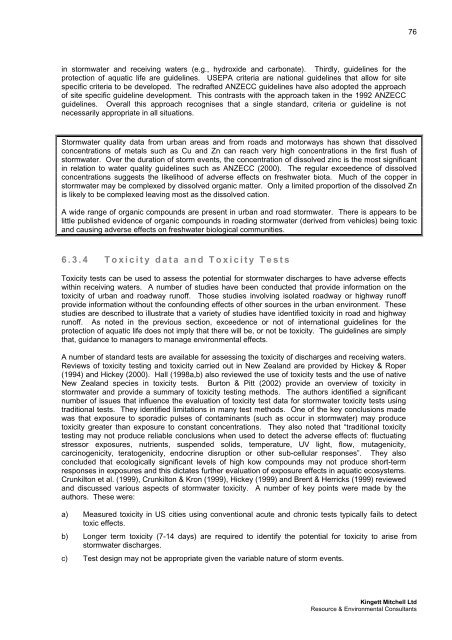The Effects of Road Transport on Freshwater and Marine Ecosystems
The Effects of Road Transport on Freshwater and Marine Ecosystems
The Effects of Road Transport on Freshwater and Marine Ecosystems
Create successful ePaper yourself
Turn your PDF publications into a flip-book with our unique Google optimized e-Paper software.
76<br />
in stormwater <strong>and</strong> receiving waters (e.g., hydroxide <strong>and</strong> carb<strong>on</strong>ate). Thirdly, guidelines for the<br />
protecti<strong>on</strong> <str<strong>on</strong>g>of</str<strong>on</strong>g> aquatic life are guidelines. USEPA criteria are nati<strong>on</strong>al guidelines that allow for site<br />
specific criteria to be developed. <str<strong>on</strong>g>The</str<strong>on</strong>g> redrafted ANZECC guidelines have also adopted the approach<br />
<str<strong>on</strong>g>of</str<strong>on</strong>g> site specific guideline development. This c<strong>on</strong>trasts with the approach taken in the 1992 ANZECC<br />
guidelines. Overall this approach recognises that a single st<strong>and</strong>ard, criteria or guideline is not<br />
necessarily appropriate in all situati<strong>on</strong>s.<br />
Stormwater quality data from urban areas <strong>and</strong> from roads <strong>and</strong> motorways has shown that dissolved<br />
c<strong>on</strong>centrati<strong>on</strong>s <str<strong>on</strong>g>of</str<strong>on</strong>g> metals such as Cu <strong>and</strong> Zn can reach very high c<strong>on</strong>centrati<strong>on</strong>s in the first flush <str<strong>on</strong>g>of</str<strong>on</strong>g><br />
stormwater. Over the durati<strong>on</strong> <str<strong>on</strong>g>of</str<strong>on</strong>g> storm events, the c<strong>on</strong>centrati<strong>on</strong> <str<strong>on</strong>g>of</str<strong>on</strong>g> dissolved zinc is the most significant<br />
in relati<strong>on</strong> to water quality guidelines such as ANZECC (2000). <str<strong>on</strong>g>The</str<strong>on</strong>g> regular exceedence <str<strong>on</strong>g>of</str<strong>on</strong>g> dissolved<br />
c<strong>on</strong>centrati<strong>on</strong>s suggests the likelihood <str<strong>on</strong>g>of</str<strong>on</strong>g> adverse effects <strong>on</strong> freshwater biota. Much <str<strong>on</strong>g>of</str<strong>on</strong>g> the copper in<br />
stormwater may be complexed by dissolved organic matter. Only a limited proporti<strong>on</strong> <str<strong>on</strong>g>of</str<strong>on</strong>g> the dissolved Zn<br />
is likely to be complexed leaving most as the dissolved cati<strong>on</strong>.<br />
A wide range <str<strong>on</strong>g>of</str<strong>on</strong>g> organic compounds are present in urban <strong>and</strong> road stormwater. <str<strong>on</strong>g>The</str<strong>on</strong>g>re is appears to be<br />
little published evidence <str<strong>on</strong>g>of</str<strong>on</strong>g> organic compounds in roading stormwater (derived from vehicles) being toxic<br />
<strong>and</strong> causing adverse effects <strong>on</strong> freshwater biological communities.<br />
6.3.4 Toxicity data <strong>and</strong> Toxicity Tests<br />
Toxicity tests can be used to assess the potential for stormwater discharges to have adverse effects<br />
within receiving waters. A number <str<strong>on</strong>g>of</str<strong>on</strong>g> studies have been c<strong>on</strong>ducted that provide informati<strong>on</strong> <strong>on</strong> the<br />
toxicity <str<strong>on</strong>g>of</str<strong>on</strong>g> urban <strong>and</strong> roadway run<str<strong>on</strong>g>of</str<strong>on</strong>g>f. Those studies involving isolated roadway or highway run<str<strong>on</strong>g>of</str<strong>on</strong>g>f<br />
provide informati<strong>on</strong> without the c<strong>on</strong>founding effects <str<strong>on</strong>g>of</str<strong>on</strong>g> other sources in the urban envir<strong>on</strong>ment. <str<strong>on</strong>g>The</str<strong>on</strong>g>se<br />
studies are described to illustrate that a variety <str<strong>on</strong>g>of</str<strong>on</strong>g> studies have identified toxicity in road <strong>and</strong> highway<br />
run<str<strong>on</strong>g>of</str<strong>on</strong>g>f. As noted in the previous secti<strong>on</strong>, exceedence or not <str<strong>on</strong>g>of</str<strong>on</strong>g> internati<strong>on</strong>al guidelines for the<br />
protecti<strong>on</strong> <str<strong>on</strong>g>of</str<strong>on</strong>g> aquatic life does not imply that there will be, or not be toxicity. <str<strong>on</strong>g>The</str<strong>on</strong>g> guidelines are simply<br />
that, guidance to managers to manage envir<strong>on</strong>mental effects.<br />
A number <str<strong>on</strong>g>of</str<strong>on</strong>g> st<strong>and</strong>ard tests are available for assessing the toxicity <str<strong>on</strong>g>of</str<strong>on</strong>g> discharges <strong>and</strong> receiving waters.<br />
Reviews <str<strong>on</strong>g>of</str<strong>on</strong>g> toxicity testing <strong>and</strong> toxicity carried out in New Zeal<strong>and</strong> are provided by Hickey & Roper<br />
(1994) <strong>and</strong> Hickey (2000). Hall (1998a,b) also reviewed the use <str<strong>on</strong>g>of</str<strong>on</strong>g> toxicity tests <strong>and</strong> the use <str<strong>on</strong>g>of</str<strong>on</strong>g> native<br />
New Zeal<strong>and</strong> species in toxicity tests. Burt<strong>on</strong> & Pitt (2002) provide an overview <str<strong>on</strong>g>of</str<strong>on</strong>g> toxicity in<br />
stormwater <strong>and</strong> provide a summary <str<strong>on</strong>g>of</str<strong>on</strong>g> toxicity testing methods. <str<strong>on</strong>g>The</str<strong>on</strong>g> authors identified a significant<br />
number <str<strong>on</strong>g>of</str<strong>on</strong>g> issues that influence the evaluati<strong>on</strong> <str<strong>on</strong>g>of</str<strong>on</strong>g> toxicity test data for stormwater toxicity tests using<br />
traditi<strong>on</strong>al tests. <str<strong>on</strong>g>The</str<strong>on</strong>g>y identified limitati<strong>on</strong>s in many test methods. One <str<strong>on</strong>g>of</str<strong>on</strong>g> the key c<strong>on</strong>clusi<strong>on</strong>s made<br />
was that exposure to sporadic pulses <str<strong>on</strong>g>of</str<strong>on</strong>g> c<strong>on</strong>taminants (such as occur in stormwater) may produce<br />
toxicity greater than exposure to c<strong>on</strong>stant c<strong>on</strong>centrati<strong>on</strong>s. <str<strong>on</strong>g>The</str<strong>on</strong>g>y also noted that “traditi<strong>on</strong>al toxicity<br />
testing may not produce reliable c<strong>on</strong>clusi<strong>on</strong>s when used to detect the adverse effects <str<strong>on</strong>g>of</str<strong>on</strong>g>: fluctuating<br />
stressor exposures, nutrients, suspended solids, temperature, UV light, flow, mutagenicity,<br />
carcinogenicity, teratogenicity, endocrine disrupti<strong>on</strong> or other sub-cellular resp<strong>on</strong>ses”. <str<strong>on</strong>g>The</str<strong>on</strong>g>y also<br />
c<strong>on</strong>cluded that ecologically significant levels <str<strong>on</strong>g>of</str<strong>on</strong>g> high kow compounds may not produce short-term<br />
resp<strong>on</strong>ses in exposures <strong>and</strong> this dictates further evaluati<strong>on</strong> <str<strong>on</strong>g>of</str<strong>on</strong>g> exposure effects in aquatic ecosystems.<br />
Crunkilt<strong>on</strong> et al. (1999), Crunkilt<strong>on</strong> & Kr<strong>on</strong> (1999), Hickey (1999) <strong>and</strong> Brent & Herricks (1999) reviewed<br />
<strong>and</strong> discussed various aspects <str<strong>on</strong>g>of</str<strong>on</strong>g> stormwater toxicity. A number <str<strong>on</strong>g>of</str<strong>on</strong>g> key points were made by the<br />
authors. <str<strong>on</strong>g>The</str<strong>on</strong>g>se were:<br />
a) Measured toxicity in US cities using c<strong>on</strong>venti<strong>on</strong>al acute <strong>and</strong> chr<strong>on</strong>ic tests typically fails to detect<br />
toxic effects.<br />
b) L<strong>on</strong>ger term toxicity (7-14 days) are required to identify the potential for toxicity to arise from<br />
stormwater discharges.<br />
c) Test design may not be appropriate given the variable nature <str<strong>on</strong>g>of</str<strong>on</strong>g> storm events.<br />
Kingett Mitchell Ltd<br />
Resource & Envir<strong>on</strong>mental C<strong>on</strong>sultants
















